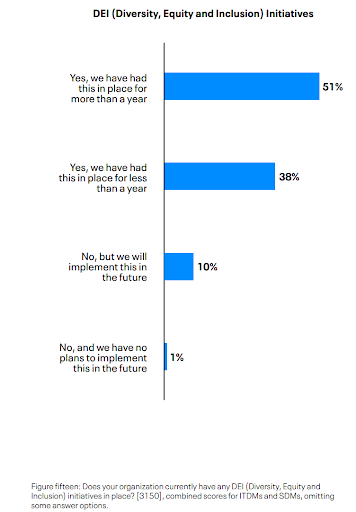About the report
The Cloudera Enterprise Data Maturity Report is a global survey of 3,150 business and IT decision makers assessing organizations’ maturity when it comes to their current capabilities and handling of data and analytics. Organizations were evaluated based on their current use of data and analytics, parties championing the use of data and the extent to which data is used across processes, the presence of enterprise data strategies, and the extent to which capabilities relating to an Enterprise Data Cloud have been achieved.
Drawing from the results of our “Cloudera Enterprise Data Maturity Report: Identifying the Impact of an Enterprise Data Strategy” survey, this series of 5 blog posts explores different ways in which a holistic, integrated enterprise data strategy enables businesses to realize desired outcomes, be it revenue, resilience or culture.
In our previous blog post, we shared the importance of setting in place a data strategy as early as possible to reap its benefits.
Diversity, equity, and inclusion (DEI) have long been linked to better business outcomes. Organizations with strong DEI strategies perform better. They have higher levels of profitability, employee retention, and innovation.
However in the last year or so, the pressure for change has never been higher. Employees are urging their organizations to do better — and organizations are listening.
DEI strategies have typically focused on changing individual behavior, rather than organizational culture. Leaders set goals to build inclusive workplaces, but often struggle to measure tangible progress. They change hiring quotas to favor underrepresented groups, implement unconscious bias training, and update company policies.
These initiatives often only lead to short-term change if the organization is unable to pinpoint the areas which need more work. Without the data to identify the way forward, organizations are ill-equipped to drive sustainable, long-term progress.
However, when organizations are truly able to manage, collect, analyze, and report on their data, they can find out where they can do better in DEI, and focus their efforts to build organizations that not only perform, but better reflect our society.
In our latest report, we analyzed over 3,000 survey responses from IT decision makers (ITDM) and senior decision makers (SDM) globally at enterprise-level companies.
And we found out that the organizations making the biggest progress on DEI understand the pivotal role that data plays in shaping more diverse, inclusive workplaces.
95% of technical decision makers agree that data and analytics are essential for driving progress on DEI
Successful change on workplace diversity and inclusion starts with a data-driven approach. This forms the foundation of setting clear, measurable goals that are part of long-term plans.
Data enables organizations to couple their DEI initiatives with actionable insight, identify where their impact will be highest, and build metrics and benchmarks for greater accountability.
We found that 96% of ITDMs and 95% of SDMs agree, stating that data and analytics is essential to building a successful and effective DEI strategy.
We are heartened to see that an overwhelming majority (89%) said that their organization has already implemented DEI initiatives, with around half reporting that the initiatives have been in place for a year or more. A further 10% indicated that it was a future goal.

Organizations with robust enterprise data strategies are doing more on DEI
In a business climate where both employees and customers are voting with their feet on DEI, having a robust data strategy in place is becoming a vital differentiator — for employee and customer retention alike.
Our research found that the companies with enterprise data strategies in place tended to be doing more to move the needle on DEI than those without. Digital leaders with established data strategies were likely to have made the most progress overall.
This suggests that these organizations are more successful at unlocking the value of their data, enabling them to make business-critical decisions while staying nimble to new challenges. When viewed alongside DEI strategy, these organizations are better able to set objectives that translate into business results, informing strategy on talent attraction, retention, development and promotion pathways that benefit employees from diverse backgrounds.
While this has a positive impact on internal organizational culture, it has also rippled outward to engage external stakeholders. Organizations with mature data strategies are better able to attract and support existing relationships with diverse customers and suppliers, and contribute to their community.
Ultimately, data has enabled organizations to bridge the gap between their strategic objectives and creating more inclusive, diverse workplaces, giving them a more purposeful, insight-driven goal.
Building diverse, resilient organizations relies on data strategy
As the pressure for change becomes ever more pressing, DEI success depends on effective data management and visibility of the entire organization.
Organizations with mature enterprise data strategies will be poised to adapt and build more diverse, inclusive companies. Being responsive to data from different sources and at all points of its lifecycle, allows them to anticipate how customer, product, and employee insights can help them develop resilience to the complex challenges ahead.
However, organizations that fail to unlock the value of their data risk getting left behind in the future — both in the race to attract top talent and to innovate.
This post represents a snapshot of the findings from our latest report: Cloudera Enterprise Data Maturity Report: Impact of Enterprise Data Strategies on Business Outcomes. To find out more, click here.
In the next blog in the series, we will explore how organizations can overcome hybrid cloud migration roadblocks.



